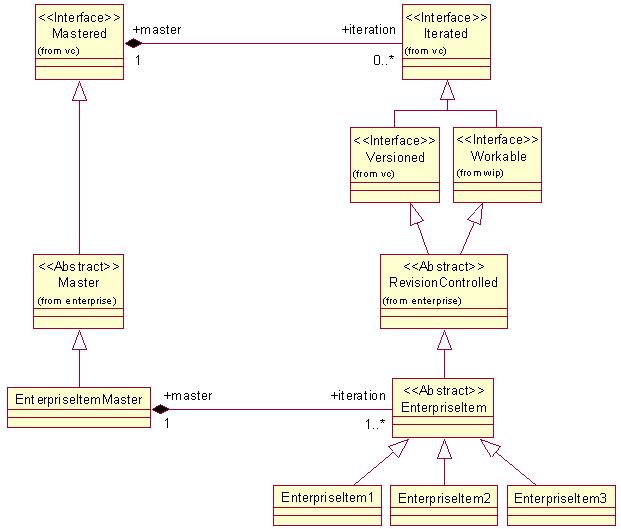The Master-iteration Design Pattern
The design pattern that you must adhere to for all versioned data is the master-iteration design pattern.
Master-Iteration Pattern
This pattern typically establishes two objects that work in concert with one another. Without one, the other should not exist and is certainly invalid. At the root are the basic abstractions:
• Mastered
• Iterated
The Mastered interface provides an abstraction of a plug-and-play component in conjunction with the Iterated interface. The intent is that, in a business model, an object would assert that it is a master by inheriting the Mastered interface. With this assertion, the business object can then be mastered through the version control service’s API. The business object must assert itself as being a kind of mastered object in order for its instance to be iterated.
The Iterated interface provides an abstraction of a plug-and-play component in conjunction with the Mastered interface. The intent is that, in a business model, an object would assert that it is an iteration (instance) by inheriting the Iterated interface. With this assertion, the business object can then be incrementally superseded, rolled back, and rolled up through the version control service’s API, provided it has a master. The business object must assert itself as being a kind of Iterated object in order for it to be incrementally changed.
The next level of master-iteration pairs defines abstract entities that start pulling together (that is, assert) all applicable capabilities from a general [virtual] enterprise perspective. The level below starts becoming more concrete where the EnterpriseItemMaster is concrete but the EnterpriseItem is not. It is at this level where the association between master and iteration is overridden with the exact named roles. However, it should be noted that cardinality of the iterations within a master can be specialized to be further constrained. Also, this association again specifies itself as a foreign key and the master can be auto-navigated from the iteration. Thus, when an iteration is fetched from the database, its master is fetched as well in one SQL statement via a database view.
Note that the iteration at this level need not be concrete for an association of this kind with the foreign key, and auto-navigation on the concrete class can have the other side as an abstract class.
At the very bottom, all of the concrete specializations of the EnterpriseItem exist. All of these specializations inherit the foreign key, auto-navigate association from EnterpriseItem. And thus, each is generated with a specific database view such that three database views are generated for EnterpriseItem1, EnterpriseItem2, and EnterpriseItem3.

